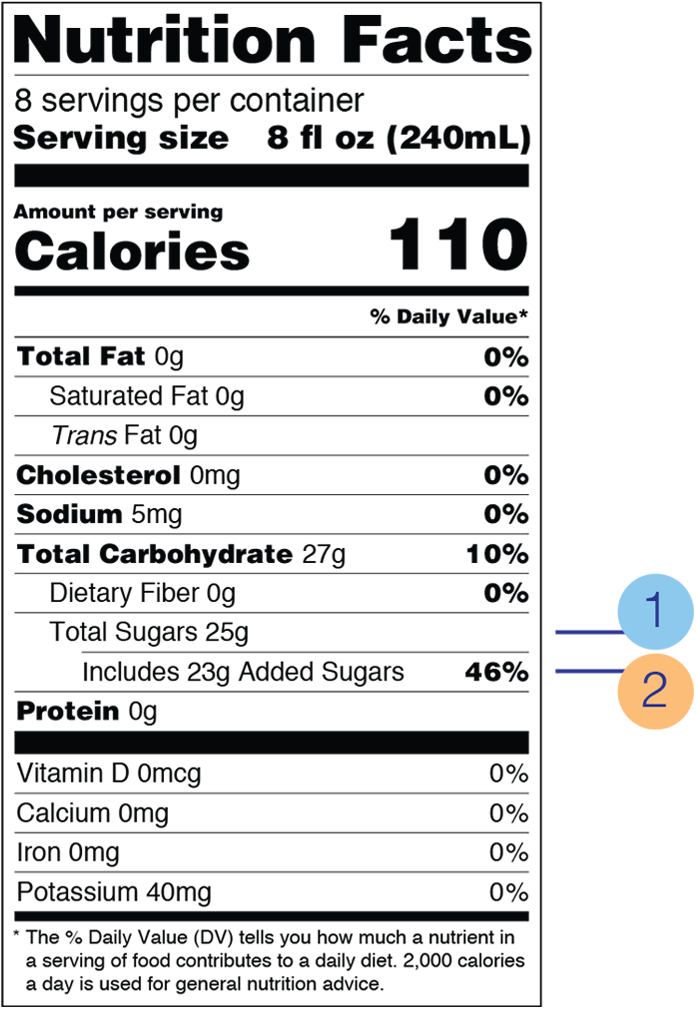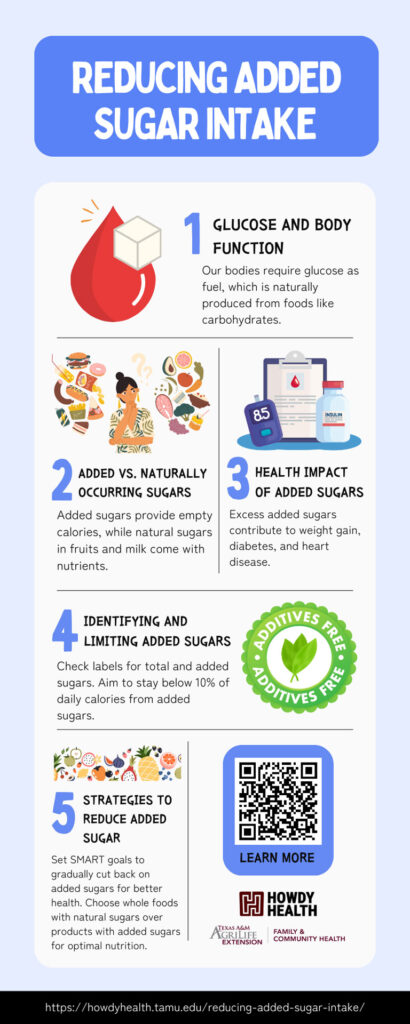Our bodies need one type of sugar, called glucose, to function, but we don’t need added sugars. Glucose is used as fuel throughout the body. Your body can make the glucose it needs by breaking down most of the food you eat, mainly carbohydrate containing foods, into glucose and releasing it into the bloodstream. Therefore, there is no need to add glucose or any other sugars to your diet.1,2 So, while added sugar may be a treat to the tastebuds on occasion, it’s best to choose mostly naturally occurring sugars in whole foods when you want something sweet.
What are added and naturally occurring sugars?
There are 2 types of sugars:
- Added sugar is the sugar and syrup put into foods during preparation, processing, or at the table.
- Naturally occurring sugar is the sugar that is found naturally in foods, such as fruit (fructose and glucose) and milk (lactose).3
The most important distinction between added and naturally occurring sugars is that added sugars are empty calories, meaning they provide calories without nutrients. Foods with naturally occurring sugars provide calories, but they also offer beneficial nutrients, like vitamins, minerals, fiber, and antioxidants.
Why limit added sugar?
Eating and drinking too much added sugar contributes to health problems like:
- Weight gain
- Obesity
- Type 2 diabetes
- Heart disease
- Kidney disease
- Non-alcoholic liver disease
- Tooth decay
- Gout (a type of arthritis).4,5,6
Unlike natural sugars found in whole foods, added sugars are generally refined and are rapidly absorbed into the bloodstream, causing a rapid rise in blood sugar (glucose) levels. This spike triggers the release of insulin, a hormone that helps cells utilize glucose for energy. When added sugar is consumed in large amounts or too frequently, the body can become less responsive to insulin, leading to insulin resistance over time. This resistance impairs the body’s ability to regulate blood sugar levels effectively, increasing the risk of type 2 diabetes, heart problems, kidney problems, problems with eyesight, and nerve issues like peripheral neuropathy (numbness in your fingers and toes).7 Additionally, frequent spikes in blood sugar can contribute to energy crashes, mood swings, and cravings, perpetuating a cycle of unhealthy eating habits. Thus, limiting added sugar intake is vital for stable blood sugar levels and overall health.8,9
Dietary sources of added sugar
The major sources of added sugar in the typical US diet are from sugar-sweetened beverages, desserts, and sweet snacks.5,10 These aren’t the only places you’ll find added sugar though. Many breakfast cereals, granola and snack bars, and flavored yogurts contain added sugars.10 You may also find added sugar in unexpected places, like in breads, condiments, and savory sauces. While sugars are often added to attract our tastebuds, they are also used to preserve foods and maintain or improve their color, texture, and/or functional characteristics.11
To identify added sugar in the foods you choose, it’s important to read and understand the Nutrition Facts Label. When reading the package label, you will want to look at 3 items:
- Total sugars – The amount of total sugar listed includes both naturally occurring and added sugars.
- Added sugars – The amount of added sugar listed is what’s added to the product during processing and preparation. This is the sugar that you want to limit in your healthy eating plan.
- Ingredients list – When reading the list of ingredients, it’s important to note that the ingredients are listed in descending order, meaning the first ingredient listed is present in the largest amount, and the last ingredient listed is present in the least amount. So, you want to make sure sugar isn’t listed in the top portion of the ingredients list, if at all. It’s also important to know the different names for sugar.


How to identify sugar?
Identifying sugar in the ingredients list is not always easy. While you may recognize names for added sugar like brown sugar, cane sugar, honey, maple syrup, molasses, and even high fructose corn syrup, other names of sugar may not be as familiar.
One helpful hint is to look for words that end in “-ose,” which is the chemical suffix for sugar.1 For example, sucrose is the name for table sugar. Other “-ose” names for sugar include glucose, fructose, dextrose, and saccharose.
You can also look for the words sugar(s), syrup, and juice alone or following other terms like beet sugar, invert sugar, malt syrup, sorghum syrup, cane juice, or fruit juice, which all indicate types of sugar that are added.
For a more comprehensive list of names for sugar, see Table 1.


How much added sugar is okay?
According to the Dietary Guidelines for Americans, those 2 years and older should keep their intake of added sugars to less than 10% of their total daily calories. For example, in a 2,000-calorie diet, no more than 200 calories should come from added sugars (about 12 teaspoons).5,10
The American Heart Association recommends a lower daily limit of added sugars - limiting intake of added sugar to no more than 6% (not more than 120 calories for a 2000-calorie diet) of total daily calories, or as follows:*
- 6 teaspoons (24 grams) for women, or roughly 100 calories from added sugar per day
- 9 teaspoons (36 grams) for men, or roughly 150 calories from added sugar per day
- 3 – 6 teaspoons for children (12 – 24 grams) (depending on their age and caloric needs).3,13
*Note: 4 grams of sugar = 1 teaspoon = 16 calories per teaspoon (4 calories per gram)
To put this in perspective, a single 12-ounce can of cola usually contains 8-11 teaspoons of added sugar and about 130-180 calories.
On average, Americans consume 22 teaspoons of added sugar daily, which amounts to about 350 empty calories from added sugars alone.11 So, in any case, the message is to work toward limiting added sugar.
Calculating your added sugar intake
To help reduce added sugar intake, it helps to know how much we’re eating. To determine how many teaspoons of added sugar are in a food, check the number of grams of added sugar on the Nutrition Facts Label and divide the number of grams by 4. (Remember, 4 grams of sugar = 1 teaspoon).
As an example, if the Nutrition Facts label for a particular food lists 12 grams of added sugar, that means that there are 3 teaspoons of added sugar in one serving of that food (12 ÷ 4 = 3).11
When reading the Nutrition Facts Labels, notice the Daily Value (DV) percentage:
- 5% DV or less of added sugar per serving is considered low
- 20% DV or more of added sugar per serving is considered high.14,15
So, look for 5% or less added sugar per serving when purchasing products, and be sure to keep serving sizes and portion sizes in mind.
How to reduce intake of added sugar
Reducing your intake of added sugar does not mean you have to give it up entirely. Making a specific plan to reduce your intake of added sugar can help you be successful. SMART (specific, measurable, attainable, realistic, and time-bound) goal setting16 can help:
S—Specific. Be specific in identifying exactly what you want to achieve. For example, “By the end of 6 weeks, I want to stop drinking soda:
- Week 1: I’ll cut down to 1 (12 oz) soda each day
- Week 2: I’ll cut down to 4 (12oz) sodas this week
- Week 3 I’ll cut down to 3 (12oz) sodas this week
- Week 4 I’ll cut down to 2 (12oz) sodas this week
- Week 5: I’ll cut down to 1 (12oz) soda this week
- Week 6: I’ll have no soda. I will have transitioned to water, fruit or fruit-juice infused water, or unsweetened iced tea.”
M—Measurable. Decide how you will measure progress toward your goal. For example, “I will measure my progress by marking on my calendar when I’ve had a soda and how many ounces.”
A—Achievable. Ensure feasible alternatives. For example, I’ll place a list of healthy alternatives to soda on my refrigerator and office desk. I’ll also have non-sugary drink options such as fruit for fruit–infused water, orange juice, and unsweetened teas on hand.”
R—Relevant . Pick something that aligns with your other efforts. For example, “I plan to lower my blood sugar levels by reducing sweetened beverages.”
T—Time-bound. Have a realistic timeline and break it down into steps. For example, “I want to achieve this by the end of 6 weeks (select the exact date) and I believe that I can start right away on this goal (select exact start date).”
Here are 3 ways to reduce added sugar by applying the SMART goals approach:
- Quick start – With the quick start approach, you would choose a timeframe (e.g., 1-3 weeks) and give up added sugar for that time period. This can help reorient your tastebuds, so that naturally sweet foods taste sweeter to you. It’s taking a break from added sugar to let your body readjust and rediscover the taste of naturally sweet foods. Then add sugar back in gradually and at the recommended amounts or less per day. If you’re able, you might try just having added sugar once a day, once a week, or on special occasions.
- Slow toward no – In this approach, you start by setting a small goal for reducing added sugar and once you attain that goal, you set another small goal, then another, and so on until you have reached the larger goal of reducing your overall added sugar intake to recommended levels or less.
- Cold Turkey – For some people the all-or-nothing-approach works best. This means giving up all added sugar down to recommended levels from the first day you set your goal.16
In each case, you’ll want to specify some ideas for how you’ll replace added sugar. For example, “I’ll infuse my water bottle each evening with fruit so that it will be flavorful for the next day”.
No matter what approach you take, remember that:
“The key to good health is eating a well-balanced diet with a variety of foods and getting plenty of physical activity. Focus on nutrition-rich whole foods without added sugars.”1
Take control of your health
Interested in learning more about ways to take control of your health? Check out all our free Howdy Health programs to step into the habit of healthy. To learn more about sugar and its impact on your health, check out our other articles, like Sugary Drink Alternatives and Sugary Snack Alternatives
Infographic
Download the PDF or share the image below to help others learn more about reducing added sugar intake.
- National Institutes of Health. Sweet stuff. September 8, 2017. Accessed June 12, 2024. https://newsinhealth.nih.gov/2014/10/sweet-stuff.
- U.S. National Library of Medicine. Blood sugar | blood glucose | diabetes. MedlinePlus. Accessed June 12, 2024. https://medlineplus.gov/bloodglucose.html#.
- American Heart Association. Added sugars. www.heart.org. May 22, 2024. Accessed June 12, 2024. https://www.heart.org/en/healthy-living/healthy-eating/eat-smart/sugar/added-sugars.
- Chatelan A, Raeisi-Dehkordi H, Salehi-Abargouei A. Substituting low-calorie sweetened beverages for sugar-sweetened beverages to prevent obesity and cardiometabolic diseases: Still a good idea? Current Developments in Nutrition. 2024;8(3):102105. doi:10.1016/j.cdnut.2024.102105 .
- Get the facts: Added sugars. Centers for Disease Control and Prevention. January 5, 2024. Accessed June 12, 2024. https://www.cdc.gov/nutrition/php/data-research/added-sugars.html?CDC_AAref_Val=https%3A%2F%2Fwww.cdc.gov%2Fnutrition%2Fdata-statistics%2Fadded-sugars.html.
- Centers for Disease Control and Prevention. Get the facts: Sugar-sweetened beverages and consumption. April 11, 2022. Accessed June 12, 2024. https://www.cdc.gov/nutrition/data-statistics/sugar-sweetened-beverages-intake.html.
- Alexander H. 4 tips to avoid sugar spikes. MD Anderson Cancer Center. October 4, 2022. Accessed June 12, 2024. https://www.mdanderson.org/cancerwise/how-to-avoid-sugar-spikes.h00-159537378.html.
- Harvard T.H. Chan School of Public Health. Carbohydrates and blood sugar. The Nutrition Source. May 9, 2024. Accessed June 12, 2024. https://www.hsph.harvard.edu/nutritionsource/carbohydrates/carbohydrates-and-blood-sugar/.
- Cleveland Clinic. Insulin resistance: What it is, causes, symptoms & treatment. Accessed June 12, 2024. https://my.clevelandclinic.org/health/diseases/22206-insulin-resistance.
- Health and Human Services. Dietary Guidelines for Americans, 2020-2025. 9th Edition. https://www.dietaryguidelines.gov/.
- Rutgers New Jersey Agricultural Experiment Station. Added sugars: Hidden in plain view. FS1305: Added Sugars: Hidden in Plain View (Rutgers NJAES). June 2019. Accessed June 12, 2024. https://njaes.rutgers.edu/fs1305/.
- University of California San Francisco. Hidden in plain sight. SugarScience.UCSF.edu. December 7, 2018. Accessed June 12, 2024. https://sugarscience.ucsf.edu/hidden-in-plain-sight/.
- American Heart Association. By any other name it’s still sweetener. www.heart.org. February 21, 2019. Accessed June 12, 2024. https://www.heart.org/en/healthy-living/healthy-eating/eat-smart/sugar/by-any-other-name-its-still-sweetener.
- Harvard T.H. Chan School of Public Health. Added sugar. The Nutrition Source. May 9, 2024. Accessed June 12, 2024. https://www.hsph.harvard.edu/nutritionsource/carbohydrates/added-sugar-in-the-diet/.
- Center for Food Safety and Applied Nutrition. How to understand and use the nutrition facts label. U.S. Food and Drug Administration. Accessed June 12, 2024. https://www.fda.gov/food/nutrition-facts-label/how-understand-and-use-nutrition-facts-label.
- Gordon C. Ecatholic. February 10, 2016. Accessed June 12, 2024. https://files.ecatholic.com/5559/documents/2016/2/NewReduceSugarEmail%202.7.2016.pdf?t=1455157373000.
- U.S. Food & Drug Administration. March 5, 2024. Accessed June 21, 2024. https://www.fda.gov/food/nutrition-facts-label/added-sugars-nutrition-facts-label





